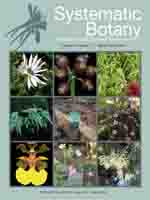We investigated the phylogeny of the New World grass Dissanthelium to explore its monophyly, to examine relationships within the genus, and to investigate its relationship with Poa. Molecular phylogenetic analyses including a thorough sampling of Dissanthelium (seventeen of the 20 species) and DNA sequences from the nuclear ribosomal ITS and plastid trnT-trnL-trnF regions suggest that Dissanthelium is not monophyletic and is nested within Poa. However, ten species form a strongly supported clade (the Dissanthelium clade) in the ITS tree. We propose treating Dissanthelium and Tovarochloa as taxonomic synonyms of Poa. We erect two new sections in Poa: sect. Dissanthelium, comprising the Dissanthelium clade and D. peruvianum, and the monotypic sect. Tovarochloa. The necessary new combinations (Poa aequalis, P. amplivaginata, P. calycina var. mathewsii, P. gigantea, P. macusaniensis, P. rahuii, and P. trollii) and new names (Poa sections Dissanthelium and Tovarochloa, P. apiculata, P. arcuata, P. boliviana, P. congesta, P. deminuta, P. linearifolia, P. parvifolia, P. serpaiana, P. swallenii, and P. thomasii) are effected herein.
How to translate text using browser tools
1 January 2012
Molecular Phylogeny of Dissanthelium (Poaceae: Pooideae) and Its Taxonomic Implications
Nancy F. Refulio-Rodriguez,
J. Travis Columbus,
Lynn J. Gillespie,
Paul M. Peterson,
Robert J. Soreng
ACCESS THE FULL ARTICLE

Systematic Botany
Vol. 37 • No. 1
January 2012
Vol. 37 • No. 1
January 2012
Bayesian
Dissanthelium
ITS
maximum likelihood
Poa
Tovarochloa
trnT-trnL-trnF




